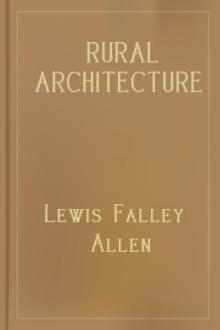Rural Architecture, Lewis Falley Allen [8 ebook reader .txt] 📗

- Author: Lewis Falley Allen
- Performer: -
Book online «Rural Architecture, Lewis Falley Allen [8 ebook reader .txt] 📗». Author Lewis Falley Allen
Now commence the annuals, which may carry you a month further into the season, when the flaunting dahlia of every hue, and budding from its plant of every size, from the height of little Tommy, who is just toddling out with his mother to watch the first opening flower, up to the top of his father's hat, as he stands quite six feet, to hold the little fellow up to try to smell of another, which, like all the rest, has no sign of odor. Then come, after a long retinue of different things—among which we always count the morning-glory, or convolvulus, running up the kitchen windows,—the great sun-flower, which throws his broad disk high over the garden fence, always cheerful, and always glowing—the brilliant tribe of asters, rich, varied, and beautiful, running far into the autumnal frosts; and, to close our floral season, the chrysanthemum, which, well cared-for, blooms out in the open air, and, carefully taken up and boxed, will stay with us, in the house, till Christmas. Thus ends the blooming year. Now, if you would enjoy a pleasure perfectly pure, which has no alloy, save an occasional disappointment by casualty, and make home interesting beyond all other places, learn first to love, then to get, and next to cultivate flowers.
FARM COTTAGES.Altogether too little attention has been paid in our country to these most useful appendages to the farm, both in their construction and appearance. Nothing adds more to the feeling of comfort, convenience, and home expression in the farm, than the snug-built laborers' cottage upon it. The cottage also gives the farm an air of respectability and dignity. The laborer should, if not so sumptuously, be as comfortably housed and sheltered as his employer. This is quite as much to the interest of such employer as it is beneficial to the health and happiness of the laborer. Building is so cheap in America, that the difference in cost between a snugly-finished cottage, and a rickety, open tenement, is hardly to be taken into consideration, as compared with the higher health, and increased enjoyment of the laborer and his family; while every considerate employer knows that cheerfulness and contentment of disposition, which are perhaps more promoted by good home accommodations for the workingman than by any other influence, are strong incentives to increased labor on his part, and more fidelity in its application.
A landed estate, of whatever extent, with its respectable farm house, in its own expressive style of construction, relieved and set off by its attendant cottages, either contiguous, or remote, and built in their proper character, leaves nothing wanting to fill the picture upon which one loves to gaze in the contemplation of country life; and without these last in due keeping with the chief structures of the estate, a blank is left in its completeness and finish. The little embellishments which may be given, by way of architectural arrangement, or the conveniences in accommodation, are, in almost all cases, appreciated by those who occupy them, and have an influence upon their character and conduct; while the trifling decorations which may be added in the way of shrubbery, trees, and flowering plants, costing little or nothing in their planting and keeping, give a charm to the humblest abode.
The position of cottages on a farm should be controlled by considerations of convenience to the place of labor, and a proper economy in their construction; and hardly a site can be inappropriate which ensures these requirements. In the plans which are submitted, due attention has been paid to the comfort of those who inhabit them, as well as to picturesque effect in the cottage itself. Decency, order, and respectability are thus given to the estate, and to those who inhabit the cottages upon it, as well as to those whose more fortunate position in life has given the enjoyment of a higher luxury in the occupancy of its chief mansion.
On all estates where the principal dwelling is located at any considerable distance from the public road, or where approached by a side road shut off from the highway by a gate, a small cottage, by way of lodge, or laborer's tenement, should be located at or near the entrance. Such appendage is not only ornamental in itself, but gives character to the place, and security to the enclosure; in guarding it from improper intrusion, as well as to receive and conduct into the premises those who either reside upon, or have business within it. It is thus a sort of sentry-box, as well as a laborer's residence.
(211)
(212) 
ELEVATION
COTTAGE Pages 211-212.
Design I.This cottage is 10 feet high, from the sill to the plates, and may be built of wood, with a slight frame composed of sills and plates only, and planked up and down (vertically) and battened; or grooved and tongued, and matched close together; or it may be framed throughout with posts and studs, and covered with rough boards, and over these clapboards, and lathed and plastered inside. The first mode would be the cheapest, although not so warm and durable as the other, yet quite comfortable when warmed by a stove. On the second plan of building, it will cost near or quite double the amount of the first, if neatly painted. A small brick chimney should rest upon the floor overhead, in the side of which, at least a foot above the chamber floor, should be inserted an earthen or iron thimble, to receive the stovepipe and guard against fire; unless a flat stone, 14 to 16 inches square, and 2 to 4 inches thick, with a pipe-hole—which is the better plan—should rest on the floor immediately over the pipe. This stone should be, also, the foundation of the chimney, which should pass immediately up through the ridge of the roof, and, for effect, in the center longitudinally, of the house. Such position will not interfere with the location of the stove, which may be placed in any part of the room, the pipe reaching the chimney by one or more elbows.
INTERIOR ARRANGEMENT.
PLAN
The main body of this cottage is 18×12 feet, with a lean-to, 8 feet wide, running its whole length in rear. This lean-to may be 8 or 9 inches lower, on the floor, than the main room, and divided into a passage, (leading to an open wood-house in rear, 10×12 feet, with a shed roof,) a large closet, and a bedroom, as may be required; or, the passage end may be left open at the side, for a wood shelter, or other useful purpose. The roof, which is raftered, boarded, and shingled in the usual mode, is well spread over the gables, as well as over the front and rear—say 18 inches. The porch in front will give additional convenience in summer, as a place to sit, or eat under, and its posts so fitted with grooves as to let in rough planks for winter enclosure in front and at one end, leaving the entrance only, at the least windy, or stormy side. The extra cost of such preparation, with the planks, which should be 1¼ or 1½ inches thick, and jointed, would not exceed ten or fifteen dollars. This would make an admirable wood-house for the winter, and a perfect snuggery for a small family. While in its summer dress, with the porch opened—the planks taken out and laid overhead, across the beams connecting the porch with the house—it would present an object of quiet comfort and beauty. A hop vine or honeysuckle might be trained outside the posts, and give it all the shade required.
In a stony country, where the adjoining enclosures are of stone, this cottage may be built of stone, also, at about double the cost of wood. This would save the expense of paint, or wash of any kind, besides the greater character of durability and substance it would add to the establishment. Trees, of course, should shelter it; and any little out-buildings that may be required should be nestled under a screen of vines and shrubbery near by.
This being designed as the humblest and cheapest kind of cottage, where the family occupy only a single room, the cost would be small. On the plan first named, stained with a coarse wash, it could be built for $100. On the second plan, well-framed of sills, plates, posts, studs, &c. &c., covered with vertical boarding and battens, or clapboarded, and well painted in oil, it might cost $150 to $200. Stone, or brick, without paint, would add but little, if anything in cost over the last sum. The ceiling of the main floor is 8 feet high, and a low chamber or garret is afforded above it, into which a swing-step ladder ascends; and when not in use, it may be hung to the ceiling overhead by a common hook and staples.
(217)
(218) 
ELEVATION
COTTAGE Pages 217-218.
Design II.This cottage is a grade beyond the one just described, both in appearance and accommodation. It is 20×16 feet on the ground, with a rear wing 26×8 feet in area. The main body is 10 feet high, to the roof, vertically boarded and battened. A snug, half-open (or it may be closed, as convenience may require,) porch shelters the front door, 5×4 feet in area. The cottage has a square or hipped roof, of a 30° pitch from a horizontal line, which spreads full two feet over the walls and bracketed beneath. The rear wing retreats two feet from the wall line of the main building, and has also a hipped roof of the same pitch as the main one, with eight-feet posts. The open end of the wing advances 6 feet toward the front of the main part for wood-house and storage. The construction of this is in the same style as Design I. The windows are plain, two-sashed, of six lights each, 8×12 glass in front, and 8×10 in the rear.
INTERIOR ARRANGEMENT.
PLAN
The front door opens into a common living room, 16×12 feet, with two windows, in which is a stove-chimney running up from the main floor next the partition, or placed over it in the chamber, and running up through the center of the roof. On one side of the living room is a bedroom, 10×8 feet, with two windows. Next to this bedroom is a large closet, 8×6 feet, with one window, and shelves, and tight cupboard within. These rooms are 9 feet high, and over them is a chamber, or garret, 20×16 feet, entered by a swing step ladder, as in Design No. I. This garret is lighted by a small





Comments (0)